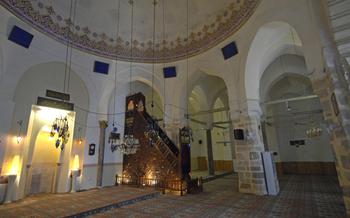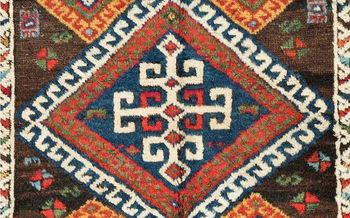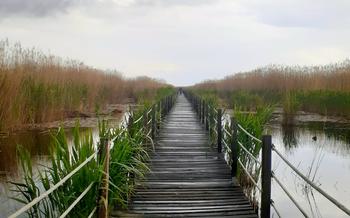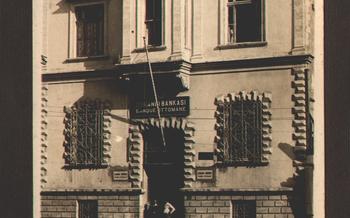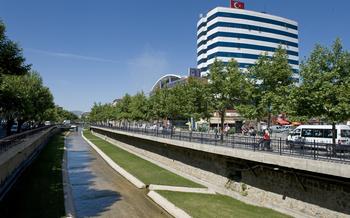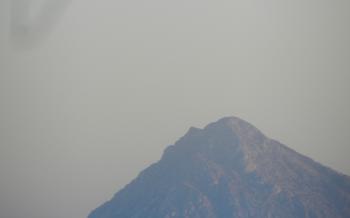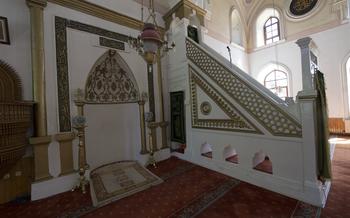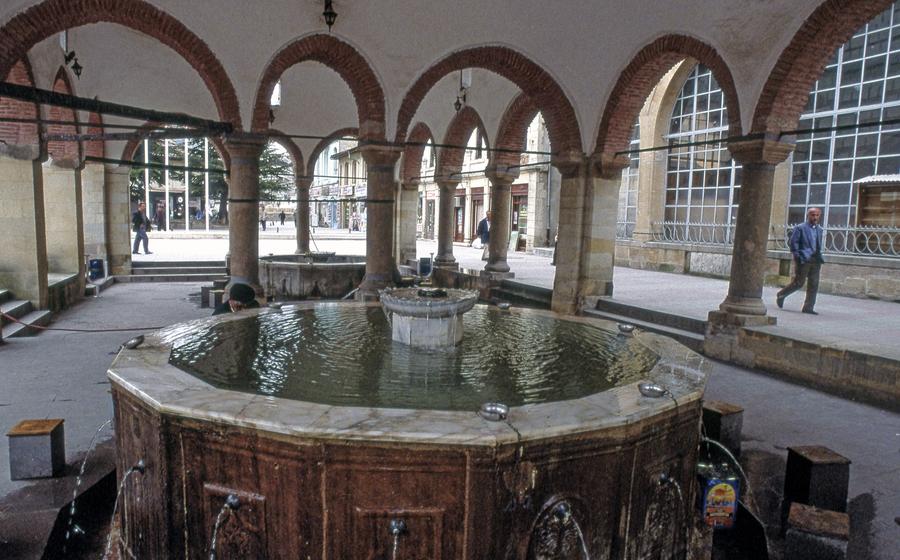
Nasrullah Mosque
- Historical Significance
- Architectural Marvel
- Spiritual Atmosphere
- Cultural Heritage
- Location and Accessibility
- Visiting Hours and Information
- Interior Exploration
- Local Cuisine
- Shopping and Souvenirs: Embracing Local Crafts and Treasures
- Photography and Social Media
- Local Festivals and Events: Embracing Kastamonu's Cultural Tapestry
- Local Guides and Tours: Unlocking the History and Significance
- Safety and Precautions
- Insider Tip: Unveiling the Hidden Gem of Nasrullah Mosque
Historical Significance
The Nasrullah Mosque stands as a testament to the rich history and cultural heritage of Kastamonu. Its construction dates back to the Beylik period, a time of great transformation and political upheaval in the region. Commissioned by the emir of the Isfendiyarid dynasty, Nasrullah Bey, the mosque emerged as a prominent religious and cultural center, serving as a focal point for the community.
Over the centuries, the mosque has witnessed countless prayers, celebrations, and gatherings, becoming an integral part of the city's spiritual and social fabric. Its enduring legacy reflects its profound influence on Kastamonu's development, cementing its status as a cherished landmark and a symbol of the city's enduring traditions.
The mosque's architectural style is a captivating blend of Seljuk and Ottoman influences, showcasing the region's diverse artistic heritage. Its intricate stone carvings, graceful arches, and soaring dome are a testament to the skill and artistry of its builders, showcasing the region's rich architectural traditions.
Architectural Marvel
The Nasrullah Mosque stands as a testament to the architectural prowess of the Beylik period. Its exterior facade captivates with intricate stone carvings that showcase the artistry of the era. The mosque's minaret, a symbol of Islamic architecture, rises majestically, offering panoramic views of Kastamonu's cityscape. The interior of the mosque is equally impressive, boasting a grand dome and graceful arches that create a sense of awe and reverence. The mihrab, the niche indicating the direction of Mecca, is adorned with intricate tile work and calligraphy, adding to the mosque's spiritual ambiance. Every element of the Nasrullah Mosque's architecture harmoniously blends to create a masterpiece that reflects the rich cultural heritage of Kastamonu.
Spiritual Atmosphere
Within the hallowed walls of the Nasrullah Mosque, a profound sense of tranquility and devotion permeates the air. As visitors step into the prayer hall, they are enveloped by an aura of spirituality that transcends the physical realm. The soft echoes of recited prayers and the gentle rustling of prayer beads create a harmonious symphony that elevates the soul.
The mosque serves as a spiritual sanctuary for the local community, a place where they gather to connect with the divine and seek guidance. During prayer times, the hall transforms into a sea of devout worshippers, their hearts united in supplication. The imam's melodious recitation of the Quran reverberates through the space, touching the hearts of the faithful.
For many locals, the Nasrullah Mosque holds deep personal significance. Stories abound of individuals who have found solace, hope, and inspiration within its sacred walls. Whether seeking guidance through challenging times or simply seeking a moment of tranquility, the mosque provides a spiritual haven for all who seek it.
Cultural Heritage
The Nasrullah Mosque stands as a testament to the rich cultural heritage of Turkey, embodying the essence of Islamic architecture and art. Its intricate design and craftsmanship reflect the deep-rooted traditions of Turkish culture, showcasing the country's artistic prowess and creativity. The mosque serves as a symbol of Islamic heritage, representing the fusion of religious and cultural influences that have shaped the region over centuries. Furthermore, the mosque is a venue for various cultural events and festivals, further cementing its role as a vibrant hub of cultural expression in Kastamonu.
Location and Accessibility
The Nasrullah Mosque is situated in the heart of Kastamonu, a city steeped in history and natural beauty. Nestled among narrow cobblestone streets and traditional Ottoman houses, the mosque's prominent location makes it a focal point of the city's skyline. To reach this architectural marvel, visitors can stroll through the charming streets of Kastamonu, taking in the sights and sounds of local life. Alternatively, public transportation options such as buses or taxis are readily available, ensuring easy accessibility from various parts of the city. Once you arrive, be sure to explore the surrounding area, home to several other historical and cultural attractions, making your visit to Kastamonu a truly enriching experience.
Visiting Hours and Information
The Nasrullah Mosque welcomes visitors during specific hours to ensure the sanctity of religious practices. To plan your visit effectively, it's crucial to note that the mosque's visiting hours may vary depending on the season and religious holidays. During regular periods, the mosque is typically open from 9:00 AM to 5:00 PM, providing ample time for visitors to explore its beauty and spiritual significance.
When visiting the mosque, it's essential to adhere to proper dress code and etiquette guidelines out of respect for the religious and cultural traditions of the site. Modest clothing that covers the shoulders and knees is recommended for both men and women. Additionally, visitors are requested to remove their shoes before entering the prayer hall and maintain a respectful demeanor throughout their visit.
For further inquiries or to obtain more detailed information, visitors can contact the local tourism office or refer to the official website of the mosque. These resources provide valuable insights into the mosque's history, architectural features, and any upcoming events or exhibitions.
Interior Exploration
As you step through the grand entrance of the Nasrullah Mosque, prepare to be awed by the vastness of its main prayer hall. Its high ceiling, supported by a series of graceful arches, creates a sense of spaciousness that invites contemplation and devotion. The intricate designs and patterns adorning the walls and ceiling draw the eye upwards, creating a harmonious visual symphony.
At the heart of the prayer hall stands the mihrab, a prayer niche that indicates the direction of Mecca. Its delicate carvings and colorful tiles form a mesmerizing focal point, guiding worshippers towards their spiritual journey. The minbar, or pulpit, stands to the right of the mihrab, its ornate design echoing the mosque's overall architectural style. From here, the imam delivers sermons and religious teachings, his words resonating throughout the tranquil space.
Take a moment to admire the intricate details that adorn every corner of the prayer hall. The stained-glass windows, with their vibrant hues, cast a warm glow upon the interior, creating a serene ambiance. The carpets, with their intricate patterns and soft texture, invite worshippers to sink into a state of deep contemplation and prayer.
Local Cuisine
After exploring the spiritual and cultural significance of the Nasrullah Mosque, indulge in the culinary delights of Kastamonu. The city's cuisine is a tantalizing blend of Turkish flavors, influenced by its rich history and diverse geography. To savor the essence of Kastamonu's culinary heritage, venture into the charming streets and discover local restaurants or cafes that serve traditional Turkish dishes.
For a truly authentic experience, try the "Tandır Kebabı," a mouthwatering lamb dish slow-cooked in a traditional clay oven. The tender meat, infused with smoky aromas, is a local delicacy that will delight your taste buds. Another must-try is "mantı," a Turkish ravioli served with garlic yogurt sauce and topped with crispy butter and paprika. These delicate dumplings are a local favorite known for their unique flavor and texture.
Kastamonu is also famous for its delectable desserts. Indulge in "Kastamonu Ekmeği," a sweet bread filled with walnuts and honey, a perfect treat to end your culinary journey on a sweet note. For those with a sweet tooth, "İncir Uyutması," a dessert made from dried figs simmered in syrup, is a must-try.
When in Kastamonu, don't miss the opportunity to visit the local market or bazaar. Here, you'll find an array of spices, herbs, fresh produce, and local delicacies. Engage with the friendly vendors, learn about traditional cooking methods, and perhaps even pick up some unique ingredients to recreate your own Turkish feast at home.
Shopping and Souvenirs: Embracing Local Crafts and Treasures
Kastamonu offers a vibrant shopping scene where visitors can immerse themselves in the city's rich cultural heritage through its local products and handicrafts. In the vicinity of the Nasrullah Mosque, a plethora of shops and markets await eager shoppers. For those seeking authentic Turkish souvenirs, the local bazaars are a treasure trove of unique items. Browse through an array of hand-woven rugs, intricate ceramics, and gleaming copperware, each piece a testament to the skill and artistry of local craftspeople.
When it comes to culinary delights, Kastamonu boasts several specialties that are sure to tantalize your taste buds. Indulge in the famous "Kastamonu mantısı," delicate dumplings filled with ground meat and served with a tangy yogurt sauce. Don't miss the chance to savor "çörek otu," a traditional pastry flavored with black cumin seeds, or sample the sweet and sticky "Kastamonu lokumu," a Turkish delight made with rosewater and pistachio.
Remember, bargaining is an essential part of the shopping experience in Turkey. Engage with the friendly vendors and try your hand at negotiating prices. It's a fun and interactive way to connect with the locals and score some great deals.
Photography and Social Media
The Nasrullah Mosque is a photographer's paradise, with its picturesque exterior and awe-inspiring interiors. Capture the mosque's grandeur from various angles, highlighting its intricate carvings and architectural details. Don't miss the opportunity to photograph the mosque's interior, showcasing the graceful arches, elegant dome, and ornate mihrab. Share your stunning shots on social media using relevant hashtags like #NasrullahMosque, #Kastamonu, and #Turkey. Inspire your followers with the mosque's beauty and encourage them to explore this hidden gem.
Local Festivals and Events: Embracing Kastamonu's Cultural Tapestry
Kastamonu comes alive with a vibrant tapestry of local festivals and events that showcase the city's rich cultural heritage and traditions. These celebrations offer visitors a chance to immerse themselves in the local way of life and experience the warmth and hospitality of the Kastamonu people.
One of the most popular events is the annual Kastamonu Cherry Festival, held in June. This festival celebrates the region's famed cherry orchards, with a variety of events, including cherry-eating competitions, cooking demonstrations, and live music performances.
Another highlight is the Kastamonu International Dance Festival, held in August. This festival brings together dance troupes from around the world, showcasing a diverse range of dance styles and traditions.
For those interested in history and culture, the Kastamonu History and Culture Festival, held in September, offers a fascinating glimpse into the city's past. Visitors can explore historical sites, attend lectures and workshops, and enjoy traditional Turkish music and dance performances.
These festivals and events provide a wonderful opportunity to connect with the local community and experience the vibrant spirit of Kastamonu. Visitors are encouraged to actively participate in these celebrations and embrace the warmth and hospitality of the Kastamonu people.
Local Guides and Tours: Unlocking the History and Significance
To truly delve into the rich tapestry of the Nasrullah Mosque's history and significance, consider booking a local guide or joining a guided tour. These knowledgeable experts will provide you with invaluable insights and anecdotes that bring the mosque's story to life. They can point out hidden architectural details, explain the symbolism behind the decorative motifs, and share stories about the people who have worshipped and served within these sacred walls.
I had the privilege of experiencing the mosque with a local guide named Mehmet, whose passion for history was contagious. He regaled us with tales of the mosque's construction, its role in the community, and the fascinating characters who have graced its halls. Mehmet's insights transformed my visit from a mere sightseeing excursion to a profound journey through time.
Whether you opt for a private guide or join a group tour, having a knowledgeable companion will elevate your experience and ensure you leave with a deeper understanding of this architectural masterpiece.
Safety and Precautions
Kastamonu is generally a safe city, and the area surrounding the Nasrullah Mosque is no exception. However, as with any travel destination, it's essential to exercise caution and take necessary precautions to ensure a smooth and enjoyable visit. Here are a few tips to keep in mind:
- Be aware of your surroundings and avoid walking alone at night, especially in dimly lit areas.
- Keep your valuables secure and avoid carrying large sums of cash.
- Respect local customs and dress modestly, especially when visiting religious sites.
- Learn a few basic Turkish phrases to communicate with locals and ask for directions if needed.
- If you have any concerns or encounter any issues, don't hesitate to approach the mosque's staff or local authorities for assistance.
By following these simple precautions, you can ensure a safe and memorable visit to the Nasrullah Mosque and Kastamonu.
Insider Tip: Unveiling the Hidden Gem of Nasrullah Mosque
As you explore the magnificent Nasrullah Mosque, don't miss the opportunity to discover its hidden gem: the tranquil courtyard garden. Nestled amidst the mosque's imposing architecture, this serene oasis offers a moment of respite and reflection. Take a break from your sightseeing and step into the courtyard, where you'll find a serene ambiance, lush greenery, and the gentle sound of water flowing from a fountain. As you wander through the garden, take notice of the intricate tile work and decorative elements adorning the walls, a testament to the mosque's rich artistic heritage. This hidden gem is a perfect spot to pause, soak in the beauty of your surroundings, and connect with the spiritual essence of the Nasrullah Mosque.


